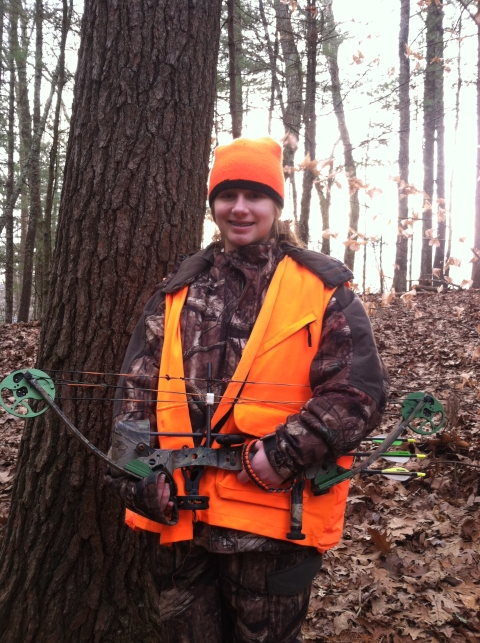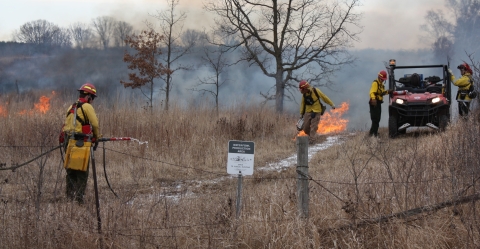What We Do
Wildlife conservation is at the heart of the National Wildlife Refuge System. It drives everything on U.S. Fish and Wildlife Service lands and waters managed within the Refuge System, from the purposes for which a national wildlife refuge national wildlife refuge
A national wildlife refuge is typically a contiguous area of land and water managed by the U.S. Fish and Wildlife Service for the conservation and, where appropriate, restoration of fish, wildlife and plant resources and their habitats for the benefit of present and future generations of Americans.
Learn more about national wildlife refuge is established to the recreational activities offered to the resource management tools used. Using conservation best practices, the Refuge System manages Service lands and waters to help ensure the survival of native wildlife species.
The primary resource management tool used on Seatuck National Wildlife Refuge is deer hunting. White-tailed deer have become increasingly more abundant over the years due to their lack of natural predator which has lead to the destruction of habitat along with an increase in conflict between humans. The annual hunting seasons helps to give white-tailed deer a "predator" thus mitigating their population growth. Migratory birds and wetland habitats are actively managed on Seatuck as well.
Management and Conservation
Seatuck National Wildlife Refuge is actively managed for migratory birds, particularly waterbirds and raptors, and to maintain and enhance habitat diversity.
Both upland and wetland habitats at the Seatuck Refuge are actively managed. Wetland management activities conducted at the refuge include restoring tidal flow, blocking manmade drainage ditches, open marsh water management, and wood duck nest box maintenance. Upland management activities include erecting osprey nesting platforms, brush hogging grasslands and upland shrub habitats, prescribed burning, restoring derelict lands to native habitat, white-tailed deer management, songbird nest box program, and an owl monitoring program which is conducted by the South Shore Audubon Society.
Wildlife monitoring conducted at the refuge includes waterbird surveys, migratory songbird and raptor surveys, white-tailed deer counts, and mosquito sampling
Deer Hunting
Seatuck National Wildlife Refuge opens 100 acres to white-tailed deer hunting November through January, and otherwise is closed to the public. All hunters are required to complete an archery hunting application with an application fee. Applications are available early August through early September on the refuge website and are due annually in September. There is no shotgun hunting opportunity at the refuge. Archery permits are issued for alternating one-week sessions, starting in November. Click here for more information on the 2021- 2022 season.
Prescribed Fire
This management technique benefits a variety of natural resources. In areas of Long Island where prescribed fire has been used, the refuge has been able to reduce fuels for protection from wildfire and restore a natural ecological process—fire—to wildlands. Burning helps to maintain fire dependent vegetation (pitch pine, warm seasonal grasses), manage grasslands, remove non‑native plants and improve feeding and nesting areas for wildlife
Wetlands
n the 1930s, ditches were added to the marshes to drain them, assuming that drier marshes would reduce the mosquito populations. However, rain water still collected in low areas and mosquitoes continued to breed, and small fish that fed on mosquito larvae could no longer get into the drier marsh areas. Pesticides developed in the 1940s suppressed the mosquitoes, but damaged the marsh ecosystem. Today, an alternative to spraying insecticides is using Open Marsh Water Management. These techniques include filling in some of the ditches and creating new tidal creeks and ponds, which allow small fish and other mosquito predators back into the marsh
Invasive Species
Refuge staff are founding members of the Long Island Invasive Species Management Area. Networking with other members and attending periodic public meetings has helped us realize the most problematic species, develop mapping standards, prioritize treatment regimens and prepare outreach materials.
Unfortunately, much of the habitat contain abundant invasive exotic plants such as purple foxglove, Japanese barberry, Japanese stilt grass and Chinese silvergrass.
Our Projects and Research
Current Projects Include
Refuge staff and Student Conservation Association interns complete saltmarsh vegetation surveys at Wertheim, Seatuck, and Lido Beach each August and September. The team surveys 203 one-meter square quadrats to assess how the salt marsh salt marsh
Salt marshes are found in tidal areas near the coast, where freshwater mixes with saltwater.
Learn more about salt marsh is responding to restoration efforts. During the surveys, the team records percent cover, stem density, and stem height. Hurricane Sandy resiliency projects involve the use of coir logs to fill former mosquito ditches, newly excavated channels to improve tidal flow, thin layer deposition, and a new living shoreline.
In the 1930s, ditches were added to the marshes to drain them, assuming that drier marshes would reduce the mosquito populations. However, rain water still collected in low areas and mosquitoes continued to breed, and small fish that fed on mosquito larvae could no longer get into the drier marsh areas. Pesticides developed in the 1940s suppressed the mosquitoes, but damaged the marsh ecosystem. Today, an alternative to spraying insecticides is using Open Marsh Water Management. These techniques include filling in some of the ditches and creating new tidal creeks and ponds, which allow small fish and other mosquito predators back into the marsh.
National Audubon Society surveyed Seatuck National Wildlife Refuge for the annual Christmas Bird Count. Participants observed 236 individual birds and 35 species within the refuge. Notable species included a northern harrier, eastern screech-owl, great horned owl, northern saw-whet owl, and peregrine falcon. The 2020 count marks the 121st year of the Christmas Bird Count tradition!
Law Enforcement
The mission of the National Wildlife Refuge System Law Enforcement program is:
"Through education and enforcement we protect our employees, volunteers, and visitors; safeguard the public’s investment in facilities and equipment; and protect the integrity of the habitat and the wildlife resources of the National trust resource which is the 150 million acre National Wildlife Refuge System.”
Laws and Regulations
To protect the natural resources of the refuge and to provide all visitors with a safe and enjoyable wildlife experience, please observe all refuge signs and regulations in handouts and brochures.




